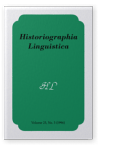Vol. 23:3 (1996) ► pp.405–434
Le Rôle Théorique de la psychopathologie du langage dans L’historiographie linguistique
Le but de ce travail est la reconstruction des lignes essentielles du débat sur la psychopathologie du langage et sur le rôle théorique qu’il a joué dans les sciences du langage d’aujourd’hui. Pour simplifier ce débat, qui commence à partir du XIXe siècle et continue encore aujourd’hui, on distingue ici deux grandes orientations. La première est représentée par les analyses du langage dans la psychiatrie clinique classique (de Emil Kraepelin jusqu’aux études récentes de Sergio Piro) et dans le cognitivisme (de Kurt Goldstein jusqu’à la neuropsychologie cognitive de la schizophrénie). La deuxième recueille les recherches de la psychiatrie philosophique: le bergsonisme (Eugène Minkowski, Pierre Janet), la phénoménologie et l’existentialisme (Heidegger et l’an-thropoanalyse de Ludwig Binswanger). De ce débat on examine surtout deux problèmes théoriques: le rapport entre régularité et liberté du langage et la définition des idées de ‘puissance’ et ‘complexité’. Dans la discussion on conclue l’impossibilité d’esquisser une théorie cognitive du langage en dehors de ses bases biologiques et, surtout, de la dimension ontologique de la conscience linguistique.
Article language: French
